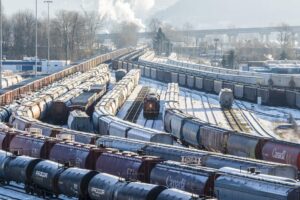Times have changed and reverse logistics became more important than ever. Companies need to embrace innovation in this area and adjust to changing consumer needs if they want to remain competitive and profitable. Anyone involved in management or entrepreneurship will benefit from becoming knowledgeable about reverse logistics given the significant influence of this frequently ignored component of the supply chain. Without further ado, let’s dive into the most important factors of reverse logistics.
What Is Reverse Logistics?
Reverse logistics is the management of commodities as they move backward through the supply chain, from buyers back to vendors or manufacturers. The management of product returns and recycling procedures make up the majority of its duties.
Reverse logistics starts with the end user and follows the supply chain in reverse, either from the end user to the distributor or from the distributor to the manufacturer. The end user may also be held accountable for the product’s final disposal in situations involving reverse logistics, which may include recycling, refurbishing, or reselling.
Stages of Reverse Logistics

Depending on the exact type of reverse logistics and the nature of the organization’s operation within its particular industry, several strategies are used to manage the return of items. Whatever the case, reverse logistics follows the same pattern and can easily be divided into 5 unique stages.
1. Processing the Return
The initiation of the return process occurs when the consumer indicates their intention to return a product. The organization is responsible for initiating and executing the return process according to its established standard operating procedure. Every organization that manages returns must have a well-organized method for starting returns. Getting return permission and examining the product’s condition are required in this phase. Additional steps in the procedure include planning return shipments, approving refunds, and delivering replacements for broken items.
2. Inspection and Categorization
Upon receiving a returned product at your location or centralized processing center, the first step is to thoroughly inspect and categorize it for the appropriate return category. Several options exist for handling returned products. They may undergo refurbishment, recycling, or preparation for resale to fulfill another order. Organizations that have optimized their reverse logistics processes will have established systems to identify and categorize returns before their arrival. For example, e-commerce brands prompt their customers to indicate the reason for return, such as receiving the wrong item, a defective item, damaged shipping materials, or other issues. This enables the company to expedite the return processing efficiently.
3. Keep Returned Products Moving
Maintaining a constant flow of returned products is crucial for minimizing waste accumulation caused by prolonged storage. Products requiring repairs should be swiftly transferred to the repair department to avoid unnecessary delays. The same principle applies to items earmarked for disposal or resale. This practice can significantly reduce your daily waste by enabling the items to seamlessly progress through the remaining stages of the supply chain.
4. Repair
Items that are moved to the repair department should be handled adequately to facilitate timely end-of-life arrangements. Repairable items should undergo swift repairs and be reintegrated into the company’s inventory, or if irreparable, properly disposed of. Also if possible, the company should proceed to sell any parts that are still marketable.
5. Recycle
Any components or products that can’t be fixed, used again, or sold once more should be delivered to the recycling area. Companies must fulfill their responsibility by ensuring the appropriate recycling and disposal of unrecoverable items. This entails considering environmental sustainability and addressing the challenges associated with wasted products. Any components that are recyclable should be handled accordingly, which may involve fully or partially disassembling the product.
The Great Value of Efficient Reverse Logistics

Historically, reverse logistics has not been a favored aspect within supply chains. Companies have often neglected and disregarded their reverse logistics departments, which continue to operate using outdated methods. Despite this, efficient reverse logistics processes offer a significant array of benefits that can generate tangible value and advantages for most businesses.
Reverse Logistics Can Reduced Losses
Implementing efficient and well-structured management practices for goods and materials in reverse logistics can lead to minimized losses and increased revenue opportunities. For instance, implementing customized return policies and ensuring accurate handling of returns can significantly reduce losses associated with returns.
Moreover, by effectively managing and distributing returned goods, businesses can tap into additional revenue streams while minimizing losses. This additional revenue can be generated through activities such as refurbishing, repairing, and recycling goods, as well as selling returned products or extracting valuable materials from them.
It Can Reduce Costs as Well
Implementing streamlined reverse logistics processes offers significant cost reduction opportunities across various areas, including storage and return shipping costs, transportation, and costs related to fraudulent returns. These costs are often distributed across different sections of the supply chain, making it challenging to address and minimize them effectively as no single department or individual is directly accountable for them. By establishing efficient reverse logistics processes, companies can not only reduce these costs but also gain better visibility and analysis of them.
Reverse Logistics Exhibit a Good Brand Image
Considering that optimized reverse logistics and returns processes lead to improved service levels and mitigate negative publicity, it naturally follows that these efforts can result in an elevated brand image. Brands that prioritize recycling end-of-life goods also gain recognition for their efficiency and sustainable practices.
It Can Also Improve Customer Retention
The possibility for increased client retention is a key benefit of effective reverse logistics. According to research commissioned by the UPS, 95% of questioned customers exhibit a hesitation to buy from a brand after having a bad return experience. Well-implemented reverse logistics systems can dramatically increase customer retention rates by putting a high priority on good customer service, offering practical and courteous return processes, and ensuring equitable treatment.
Improve Your Reverse Logistics Plan
The future of reverse logistics revolves around minimizing disruptions caused by returns. The volume of returns is increasing in both the e-commerce space and the retail sector as a whole. Companies can use reverse logistics to seamlessly integrate all components of the returns process in order to successfully navigate this environment.
Optimize your reverse logistics strategy with Interlane logistics company in Canada and unlock greater efficiency, reduce costs, and enhance customer satisfaction. A well-crafted reverse logistics plan can offer a number of advantages for your company!















